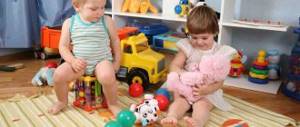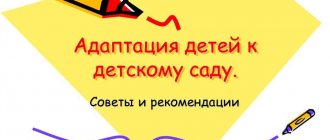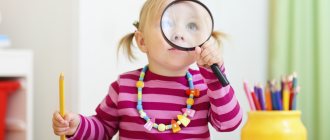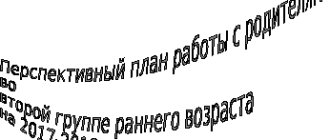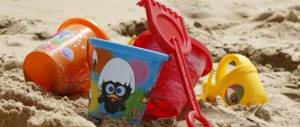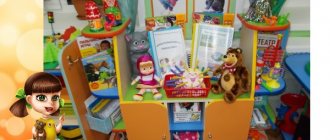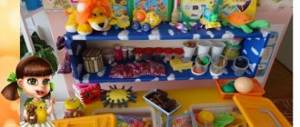Organization of cognitive and research activities of young children.”
“Know how to open one thing to your child in the world around him, but open it in such a way that a piece of life sparkles with all the colors of the rainbow. Always leave something unsaid so that the child will want to return again and again to what he has learned.”
Sukhomlinsky V. A.
“The child is playing with blocks, Easter cakes, and a ball...” we say when we see the child doing something. Od
However, children begin to play in the full sense of the word by the age of three. At an early age, the child explores objects and performs simple actions with their help. Thus, he learns about the world around him. And every tiny discovery delights him. The task of teachers is to provide younger preschoolers with the opportunity for safe and varied exploration.
Children 1.5–3 years old have a sufficient level of development of motor skills and coordination of movements to carry out independent exploration. Often parents mistake for pranks what for the child was a process of acquiring new knowledge.
Early age is a period of active knowledge of the world around us and the child’s research activity with the objective world.
The child explores the various properties of objects: shape, size, draws simple cause-and-effect relationships between them, studies the nature of the movements and relationships of objects. Psychologists call these actions instrumental or object-based, since they involve the influence of one object on another to achieve a certain result. The meaning of actions is revealed to the child by an adult.
Little children are explorers by nature. They want to experience everything themselves, to be surprised by the unknown.
Is it possible to organize research activities with children of primary preschool age? Yes! Young children are characterized by increased interest in everything that happens around them. Every day, children learn more and more new objects, strive to learn not only their names, but also their similarities, and think about the simplest reasons for the observed phenomena. While maintaining children's interest, you need to lead them from acquaintance with nature to understanding it. Since cognitive-research activity originates in early childhood in the depths of object-manipulative activity, representing a simple, seemingly “purposeless” experimentation with things, during which perception is differentiated, the simplest categorization of objects by color, shape, purpose arises, sensory standards are mastered , simple weapon actions.
Early age is a period of active experimentation of a child with the objective world. Everything that surrounds the baby - things, toys, animals, plants, water, sand and much more - arouses his interest. He loves to explore new objects, experiment with a variety of substances and materials: water, sand, snow, stones, clay, paints.
The development of cognitive activity in children is a topical issue today. To prove this, we can rely on the words of N.N. Poddyakov: “The reasons for the intellectual passivity of children that occur often lie in the limitations of their intellectual impressions and interests.”
Thus, at the age of 2-3 years, the predominant objects should be for research in real action with a small inclusion of figurative and symbolic material.
This is the basis for the active introduction of research activities into the practice of working with young children. Children develop curiosity - a desire to understand the patterns of the world around them. That is why it is very important to make a child’s interest and curiosity a manageable process, and most importantly, useful for him from the point of view of cognitive, moral, and aesthetic development. The child’s cognitive interest should give rise to good feelings in him and be turned in a useful direction.
For young children, simple materials of the figurative-symbolic type are also needed, which allow expanding the range of the child’s ideas, developing speech, and promoting the child to the level of figurative representation of the world.
These are sets of pictures with images of simple geometric shapes, household objects, animals, plants and fruits, cut (folding) cubes and pictures (of 2-4 elements, paired pictures for comparison, simple plot pictures, series of pictures (stories in pictures) with a sequence from 2-3 events or everyday actions, etc.
This material stimulates research and ordering in the form of simple groupings (according to the sensory properties and meaning of the depicted objects, the establishment of simple relationships between elements (whole - parts) and time relationships (first - then). To expand the range of ideas and simple grouping, a variety of figurative toys - three-dimensional and flat animal figurines, sets of models of fruits and vegetables.
With small children, the simplest actions are performed, for example, laying out pictures of a natural phenomenon that was observed on a walk or dressing a doll in the clothes that it needs for the season, while the dressing sequence is fixed both on the doll and according to the diagram, and when dressing on walk. Introduce children to the fact that plants, birds, fish and humans cannot live without water. Introduce children to the properties and qualities of such materials as stones: they can be large and small, heavy and light, hard, and sink. Stones can be used to make buildings; We also introduce children to cereals such as peas and beans.
The main content of cognitive research activities involves the formation of the following ideas:
1. About materials (sand, paper, fabric, wood).
2. About natural phenomena (wind, snowfall, sun, water; games with the wind, with snow, etc.).
3. About the world of plants (methods of growing from seeds, bulbs, leaves).
4. About methods of studying an object.
5. About the objective world.
Experimenting with sand and water opens up great opportunities for children's cognitive development. Kids get new impressions, experience positive emotions, and get acquainted with the properties of water and sand.
Playing with water promotes the development of exploration in young children. First, tell them that water is liquid and can be poured into a cup, and offer the kids the game “Drink the Animals.” Place small glasses near the animals and invite the child to pour water from a jug into each glass. While playing, children become convinced that water is liquid, and they also learn to pour water from one vessel to another, trying not to spill it.
Next, pouring water from a jug into an inflatable ball, glass, bottle, or mold to clearly show the baby that water can take different shapes. You can play the game “Wizards” with your children using water and multi-colored gouache. Children will watch with interest how clear water, with the wave of a magic wand-brush, suddenly turns green, red, blue or yellow. During this game, children learn that water can be transparent and colored, and the names of colors are also learned. Such experimental games cause children great joy, surprise from their small discoveries, a feeling of satisfaction from the work done, and an interest in learning new things.
One of the fun things for children of this age is playing in the sandbox. Kids like to pour dry sand from palm to palm and pour it into a bucket. Teachers can combine play and experiment. First, invite your child to pour dry sand into a bucket and pour it back. You can help the Bunny or Mouse clear the sand from small stones using a sieve. This is how we learn to sift out the sand. During the game, we draw the kids’ attention to the main property of dry sand – flowability. Consolidating knowledge about this, show children how to pour sand into a bottle using funnels.
Next, introduce children to raw sand. We moisten the dry sand with water and together with the children we notice that it no longer crumbles, it has become sticky and you can make Easter cakes from it. And here there is wide scope for imagination. Various games can be played with wet sand. In addition to Easter cakes, you can make houses for animals. You can also make pies using molds.
Thus, in the process of playing with sand, children learn that dry sand consists of small grains - grains of sand, it is free-flowing, but it is impossible to build Easter cakes from it, and wet sand is sticky and wonderful Easter cakes are made from it. In addition to acquiring new knowledge, during such games, children replenish their vocabulary, develop fine motor skills and develop an interest in creativity.
When organizing experimental activities for young children, it is necessary to take into account the age characteristics of children.
All proposed activities are emotionally charged and evoke positive emotions and a desire to act in children.
For children of early preschool age, the principle of repetition is relevant, so it is necessary to constantly return to many experiences and experiments. Thanks to targeted work on experimental activities, children become more observant and inquisitive.
Children are explorers by nature. They constantly strive to experiment and seek new information about the world around them. Not only teachers, but also parents should be assistants in their research activities. Parents should know how to arouse their children’s interest in learning about the world around them, and what methods to use when organizing this or that activity. It is important to draw the attention of parents to the need to develop research activities in children and that is why, to involve parents in jointly solving these issues using the following forms:
Parents Corner
Conversations
"Family Meetings"
Thematic consultations
Polls, questionnaires.
Aim parents to understand that curiosity is a character trait that needs to be developed from an early age, and that the innate need for new experiences forms the basis for the harmonious all-round development of a child.
In children aged 2–3 years, it is very important to develop an interest in learning about the world around them. Interest encourages the search for new knowledge. I would like to note that recently psychologists have been drawing the attention of parents and teachers to the fact that this age is particularly sensitive to speech, sensory, mental, physical and other areas of personality development. We, teachers and parents, must take this into account and direct our experience, knowledge and skills to ensure that our children grow up inquisitive, interested in new, unknown things in the world around them, and love to experiment.
Bibliography:
1. Krulekht M.V. A child learns the objective world and gets involved in work // Junior preschooler in kindergarten.
2. Poddyakov N. N. A new approach to the development of creativity in preschool children // Questions of psychology, 1990, No. 1 p.: 16 – 19.
3.Child in the world of search. Program for organizing the search activities of preschool children / ed. O. V. Dybina. - M.: Sphere shopping center, 2005.
4. Shchetinina A. M. Teaching a preschooler to think: games, activities, diagnostics. - M.: TTSsfera., 2011
Cognitive development of young children through games - experiments
Adults, unfortunately, very often do not understand children and regard their research activities as aimless. But the child is engaged precisely in understanding the world through experimentation. Nature set him the task of studying and remembering the properties of all objects without any selectivity, without dividing them into necessary and unnecessary, useful and useless.
We consider it impossible to develop the experimental activities of children without the participation of the teacher and the experimental goals and objectives set, because without the assigned tasks the child will simply manipulate objects. To implement this section, we have developed long-term plans, games-experiments with sand and water, for children from 1.6 to 3 years old, aimed at developing experimental activities. The games were developed taking into account age and age-related characteristics, from simple to complex.
The most important condition for organizing practical experimentation is equipment. The group contains one filled with calcined sand. At first, it gives the child great pleasure to get acquainted with the material through simple actions: pouring, sifting, pouring sand from a larger container into a smaller one and vice versa. For these purposes, we offer children sieves, scoops, funnels, cups, mills, spoons, boards, and bottles. When a child masters the actions associated with molding pies, we use plastic molds, buckets, spatulas, and scoops.
To experiment with water, we use plastic basins, watering cans, bowls, tubes, whisks, pebbles, shells, boats made of foam plastic and bark, etc. To prevent clothing from getting wet, especially in winter, oilcloth aprons were made for playing with water. In order for the water to give children a pleasant feeling, we take care of the temperature (+ 18°, + 20°), monitor the duration of the game and the condition of the children’s clothing.
In games, children consolidated their knowledge of dry (pours) and wet (sculpts) sand (“Pour, sculpt”). We learned how to lay out molds from wet sand (“Masha’s doll’s birthday”) and independently determine the qualities of the sand - dry, wet. (“Visiting the mouse”). We gained knowledge about the properties of water - it can become colored (“Multi-colored water”), turn into ice (“What different water”), became acquainted with the different temperatures of water (“Who woke up the baby whale”), etc.
In addition, we used a variety of methods in our work.
Game games are the leaders at this age; not a single experimental game was complete without a hero or a surprise moment; children happily helped the nesting doll find beads by sifting dry sand through a sieve. Whipped soap foam for the doll (“Soap Bubbles”). We made snow cakes from snow for the snowman. Our heroes played outdoor games with children in order to relieve psychomotor stress and create positive emotions. The children showed the heroes how they can play with their fingers (finger gymnastics “Water, water”, “The wind blows in our faces”, etc.). Along with gaming methods, verbal methods were used - clarification, clarification, explanation, literary words (poems, nursery rhymes, riddles), instructions for action. Using reproductive methods, such as mirror actions - “Pour some water into a glass” and synchronous actions “Let’s pour sand into a bucket together”, children developed self-confidence and the ability to repeat what an adult does.
